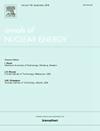Development of a non-intrusive ROM for 5 × 5 rod bundles of PWR using small sample data
IF 1.9
3区 工程技术
Q1 NUCLEAR SCIENCE & TECHNOLOGY
引用次数: 0
Abstract
This study aims to develop an efficient Reduced-Order Model (ROM) for rod-type fuel assemblies in pressurized water reactors (PWR), essential components of typical PWR cores. This paper integrates Proper Orthogonal Decomposition (POD) with machine learning (ML) for the rapid prediction of the thermal–hydraulic (TH) parameter field in the reactor core, aiding in real-time monitoring and optimization. This paper focuses on validating the model’s feasibility and accuracy for PWR core components operating at 15.5 MPa pressure. To verify the applicability of the POD method in predicting small sample data under actual operational conditions, this study uses actual operational boundaries from nuclear power plants and 121 sets of small sample data as boundary conditions. Extensive Computational Fluid Dynamics (CFD) calculations are conducted to collect data for constructing a snapshot matrix and further developing the ROM. A data-driven approach is employed to explore the relationship between POD coefficients and boundary conditions, achieving rapid prediction of the TH parameter field under any combination of boundary conditions. The study compares the predictive performance of four machine learning algorithms: Radial Basis Function Neural Networks (RBFNNs), K-Nearest Neighbors Regression (KNN), Random Forest Regression (RF), and Gradient Boosting Regression (GBR). Results show that all ML algorithms can construct ROM and predict the TH parameter field with reasonable accuracy for test data. Among them, Random Forest Regression achieves the highest precision, with an average Mean Square Error (MSE) of approximately 3.24 × 10−4 and a coefficient of determination (R2) of around 0.96. Furthermore, the average prediction time for the detailed three-dimensional parameter field per component is only 15.0 s.
求助全文
约1分钟内获得全文
求助全文
来源期刊

Annals of Nuclear Energy
工程技术-核科学技术
CiteScore
4.30
自引率
21.10%
发文量
632
审稿时长
7.3 months
期刊介绍:
Annals of Nuclear Energy provides an international medium for the communication of original research, ideas and developments in all areas of the field of nuclear energy science and technology. Its scope embraces nuclear fuel reserves, fuel cycles and cost, materials, processing, system and component technology (fission only), design and optimization, direct conversion of nuclear energy sources, environmental control, reactor physics, heat transfer and fluid dynamics, structural analysis, fuel management, future developments, nuclear fuel and safety, nuclear aerosol, neutron physics, computer technology (both software and hardware), risk assessment, radioactive waste disposal and reactor thermal hydraulics. Papers submitted to Annals need to demonstrate a clear link to nuclear power generation/nuclear engineering. Papers which deal with pure nuclear physics, pure health physics, imaging, or attenuation and shielding properties of concretes and various geological materials are not within the scope of the journal. Also, papers that deal with policy or economics are not within the scope of the journal.
 求助内容:
求助内容: 应助结果提醒方式:
应助结果提醒方式:


